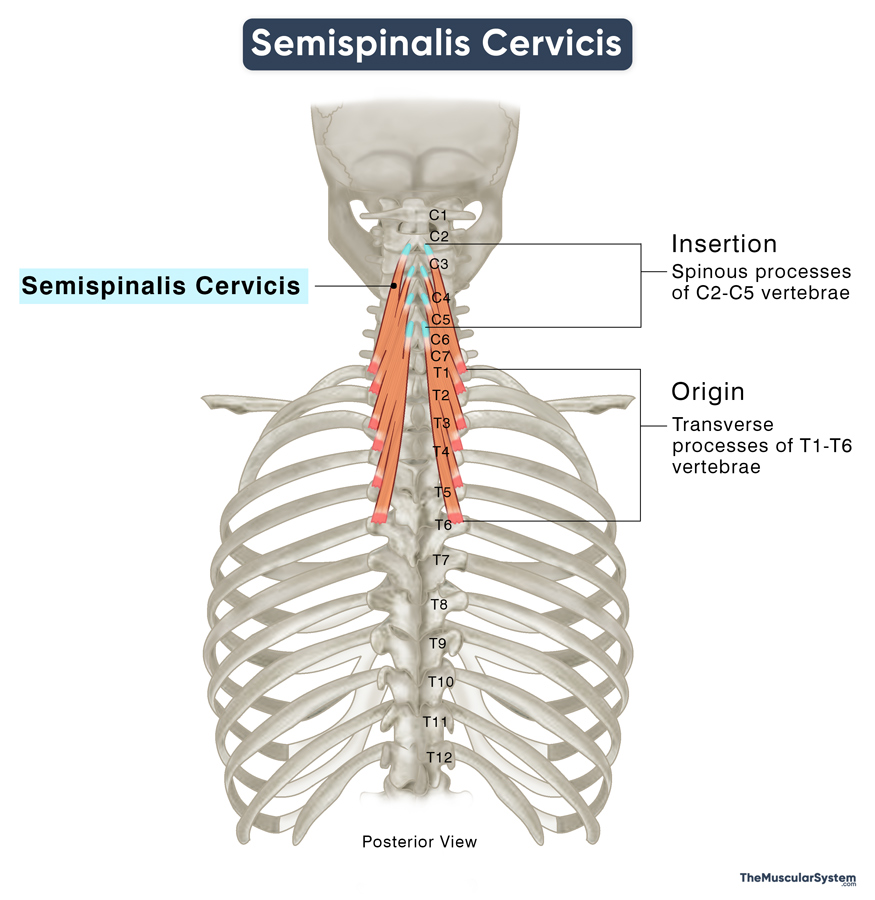Semispinalis Cervicis
Last updated:
22/10/2024Della Barnes, an MS Anatomy graduate, blends medical research with accessible writing, simplifying complex anatomy for a better understanding and appreciation of human anatomy.
What is the Semispinalis Cervicis
Semispinalis cervicis, also known as semispinalis colli, is a relatively small muscle belonging to the group of intrinsic back muscles. It is one of the three semispinalis muscles that constitute the deep layer of the intrinsic back muscles, along with the multifidus and rotatores muscles. Located in the neck and upper back region between the shoulder blades, it is one of the muscles that help with the movements of the head and neck.
Anatomy
Location and Attachments
| Origin | Transverse processes of T1 to T6 vertebrae |
| Insertion | Spinous processes of C2 to C5 vertebrae |
Origin
The muscle originates via narrow tendons from the transverse processes of the 1st to 6th thoracic vertebrae. As a relatively small muscle, its tendons travel upward as thin muscular fascicles, crossing the thoracic spine to reach the cervical spine.
Insertion
Once the fascicles reach the cervical spine, they insert into the posterior aspect of the spinous processes of the 2nd to 5th cervical vertebrae. The muscle fibers originating from T1 extend upward to insert into C2 (axis), while fibers originating from the successive thoracic vertebrae insert progressively lower on the cervical spine, with those from T6 inserting into C5. Conversely, the fascicle extending from T1 to C2 is often the thickest and most muscular part of the muscle.
Relations With Surrounding Muscles and Structures
The semispinalis cervicis is covered on its dorsal and lateral sides by the semispinalis capitis. The two create a muscular layer that covers the deeper intrinsic back muscles. It also has the splenius muscles lying superficially.
On the deep side, the muscle lies superficial to the multifidus muscles in the cervical and thoracic regions. Medially, the muscle is adjacent to the spinous processes of the cervical and thoracic vertebrae.
Function
| Action | Extending, tilting, and rotating the head and neck |
Semispinalis cervicis works with the semispinalis capitis and thoracis muscles to help with movements of the head and neck. When the muscle contracts bilaterally, or on both sides, it helps with extending the head and cervical spine – as you would do to look at something overhead. When it contracts unilaterally or only on one side, it assists in tilting the head to the same (ipsilateral) side and rotating the head and neck to the opposite (contralateral) side.
Innervation
| Nerve | Dorsal rami of the lower cervical nerves |
The semispinalis cervicis muscle is innervated by the medial branches of the dorsal rami from the upper cervical spinal nerves, specifically C3 to C6.
Blood Supply
| Artery | Occipital, vertebral, and deep cervical arteries |
The muscle’s blood supply comes from the descending branch of the occipital artery, with the vertebral and cervical arteries being other key contributors. The dorsal rami of the upper posterior intercostal arteries provide additional blood supply.
References
- Semispinalis Cervicis Muscle: Kenhub.com
- Semispinalis Cervicis Muscle: GetBodySmart.com
- Semispinalis Colli Muscle: Elsevier.com
- Semispinalis: TeachMeAnatomy.info
Della Barnes, an MS Anatomy graduate, blends medical research with accessible writing, simplifying complex anatomy for a better understanding and appreciation of human anatomy.
- Latest Posts by Della Barnes, MS Anatomy
-
Suboccipital Muscles
- -
Rectus Capitis Posterior Minor
- -
Rectus Capitis Posterior Major
- All Posts






